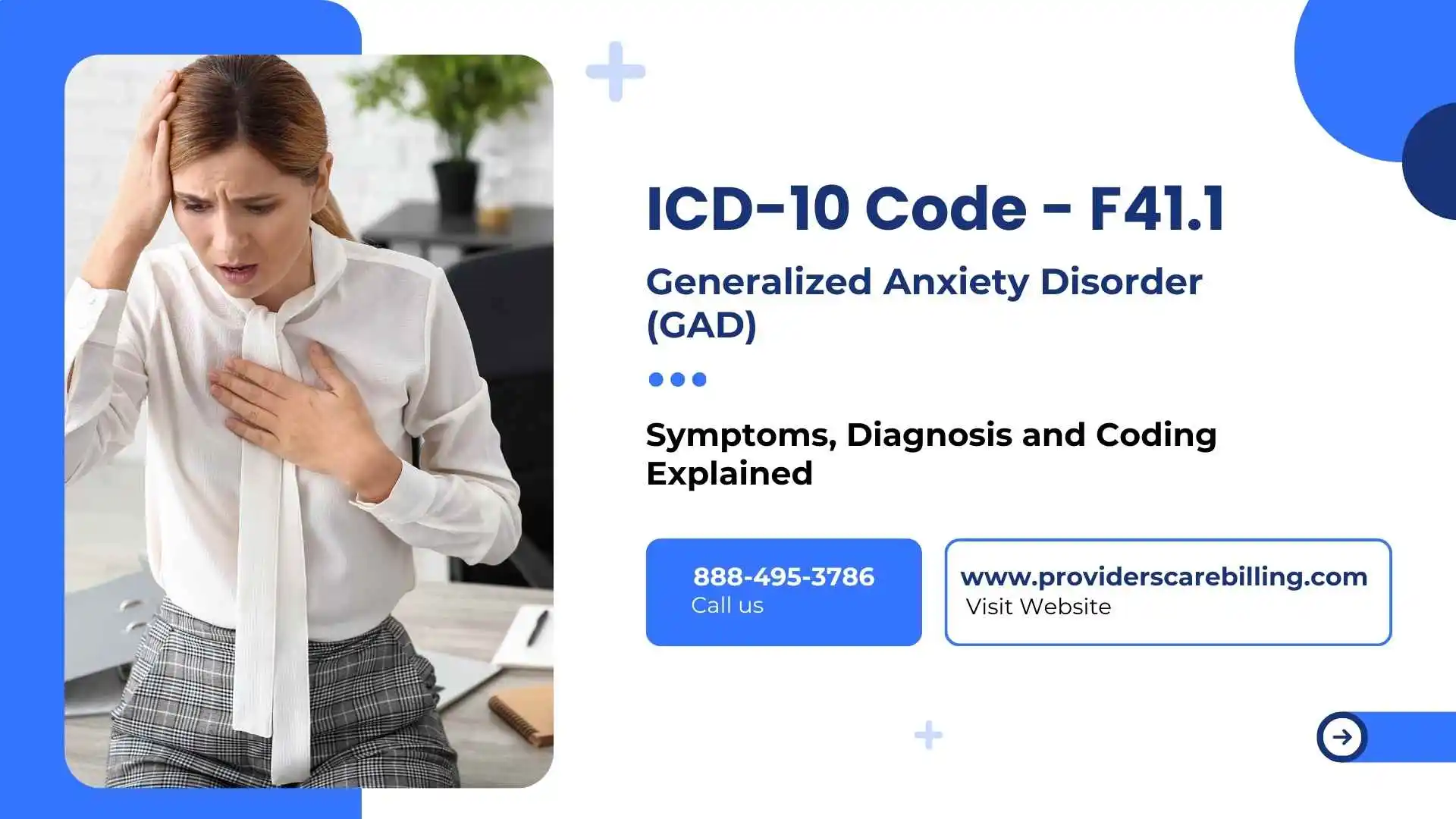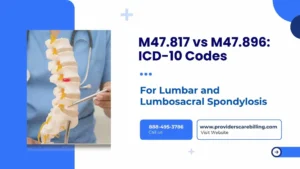Did you know about 6.8 million adults are affected by Generalized Anxiety Disorder in the U.S. every year?
That’s roughly 3.1% of the population – and yet, less than half of those affected ever receive treatment. Health professionals use the ICD-10 code F41.1 code for diagnosing patients with generalized anxiety disorder. It is a medical condition that features long-term intense fears that disrupt regular day-to-day activities of patients. Individuals with GAD have pervasive feelings of anxiety for most days, even in the absence of any rationale for concern.
F41.1, as a widely recognized diagnostic code, is utilized universally by healthcare practitioners not only for the treatment of the patient but also for the reason of obtaining the correct diagnosis, life-related payments, extracting payment from medical insurance companies, and devising the appropriate treatment strategies. This blog will guide you about the right use of ICD-10 codes, their relationship to ICD-9 codes and which CPT codes are used for the treatment of this disorder.
What is Generalized Anxiety Disorder?
Generalized Anxiety Disorder(GAD) produces unceasing worrying about various matters that exist without specific reasons. The anxious disposition of people with this medical condition persists through time, even when there’s nothing to worry about. It happens throughout the day. Here are some common symptoms of GAD.
- Trouble sleeping
- Fatigue
- Muscle tension
- Difficulty concentrating
- Irritability
- Feeling overwhelmed
ICD-10 Code F41.1 is not the only diagnosis code for this disorder. Here are some other codes for other anxiety disorders:
- F41.0 – Panic disorder
- F41.3 – Other mixed anxiety disorders
- F41.8 – Other specified anxiety disorders
- F41.9 – Anxiety disorder, unspecified
- F41.1 – Generalized anxiety disorder, unspecified subtype4
These codes help to differentiate between the types of anxiety…which is a must in diagnosis and filing of claims. In today’s healthcare system, these codes help in maintaining patients’ EHR (Electronic Health Records), so that professionals can communicate and monitor progress to apply evidence-based treatments.
Understanding the link between ICD-10 and ICD-9 codes
Before ICD-10 became the standard, the US healthcare system used ICD-9 codes to diagnose medical conditions. Even though it was ruled out on October 1, 2015…you still might see them in older medical records. For example, here are some commonly seen ICD-9 references that we come across…
- 300.02 – Generalized Anxiety Disorder
- 300.00 – ICD Code for Anxiety, unspecified
- 300.01 – Panic disorder without agoraphobia
- 300.09 – Other anxiety states
Why does Understanding these codes matter?
Let’s tell you a short story to understand better…
While going through a patient’s records for an appointment, Dr. Malik noticed the codes 300.02, 300.00, and 300.01. These seemed unknown to him as he had only gotten training regarding ICD-10 codes. These are all ICD-9 codes.
Not knowing how to interpret these codes accurately, he sought our assistance. Our specialists assisted him with the entire healthcare coding process of identifying the matching ICD-10 codes for 300.02 to F41.1 as Generalized Anxiety Disorder and 300.01 to F41.0 as Panic Disorder until the patient records were brought up to date within their current classification system.
This streamlined processes, and most importantly, enabled the patient to receive appropriate medical attention and seamless treatment protection.
Common Variations and Abbreviations for Anxiety Codes
If you are dealing with anxiety disorders like GAD, you will come across different versions of ICD10-Code F41.1. These variations can appear in EHRs, insurance forms, or even international documentation.
Here’s a guide to some of the most common variations of these codes:
| Variation / Abbreviation | Meaning / Usage |
| f41 1, f411, f 41.1, f4.1, f 41 ICD 10 | Common formatting variations of ICD-10 Code F41.1 |
| DX f41.9 | Diagnostic shorthand for unspecified anxiety disorder |
| F41 9 Diagnosis | Refers to a diagnosis of unspecified anxiety disorder |
| CID F41 | Used in Portuguese or Spanish systems; “CID” = Clasificación Internacional de Enfermedades |
| Anxiety DSM code | Refers to anxiety classifications in the DSM system |
| Anxiety F code | General reference to ICD-10 “F” codes related to mental health |
| F code Unspecified Anxiety Disorder | Indicates anxiety without a specific subtype |
| Fcode Adjustment Disorder | Sometimes used when anxiety is related to an adjustment or stress-related condition. |
These variations assist in understanding documentation accurately, especially when dealing with different healthcare platforms or maintaining EHRs
Frequently Asked Questions
Which ICD-9 code is used for anxiety?
Before October 1, 2015, ICD-9 codes were used in the diagnosis of different disorders. Their codes can still be found in older medical records. Here is a list of ICD-9 codes, which were later updated to IDC-10 codes after 2015.
| ICD-9 Code | Description |
| 300.00 | Anxiety state, unspecified |
| 300.02 | Generalized anxiety disorder(GAD) |
| 300.09 | Other anxiety states |
| 300.10 | Hysteria |
| 300.11 | Conversion disorder |
| 300.12 | Dissociative amnesia |
| 300.13 | Dissociative fugue |
| 300.14 | Dissociative identity disorder(Multiple Personality Disorder) |
| 300.15 | Dissociative disorder, unspecified |
| 300.20 | Phobia, unspecified |
| 300.21 | Agoraphobia with panic attacks |
| 300.22 | Agoraphobia without mention of panic attacks |
| 300.23 | Social phobia(social anxiety disorder) |
| 300.29 | Other isolated or specific phobias |
| 300.3 | Obsessive-compulsive disorders |
| 308.0 | Acute reaction to stress |
| 309.81 | Posttraumatic stress disorder(PTSD) |
Is F41.1 the same as anxiety disorder unspecified?
That’s not quite correct. F41.1 is allocated exclusively to Generalized Anxiety Disorder. In instances of anxiety that don’t fully qualify for GAD or are ambivalent, practitioners may resort to using F41.9 (anxiety disorder, unspecified).
What CPT code is used for anxiety?
CPT codes are not diagnosis codes. They are actually used to identify procedures and that’s why they are also important. Here are some commonly used CPT codes for anxiety.
| CPT Code | Service Description |
| 90791 | Psychiatric diagnostic evaluation |
| 90832 | Psychotherapy, 30 minutes |
| 90834 | Psychotherapy, 45 minutes |
| 90837 | Psychotherapy, 60 minutes |
| 99213/99214 | Office/outpatient E&M visits |
| 96127 | Brief emotional/behavioral assessment |
These codes are used for billing for therapy sessions, psychiatric evaluations, and brief behavioral assessments related to anxiety.
Can GAD be coded along with other conditions?
Yes, GAD can be coded alongside other physical or mental health conditions. Examples:
- F41.1 + F32.0 (Mild depression)
- F41.1 + R07.9 (Chest pain)
- F41.1 + F06.4 (Anxiety disorder due to known physiological condition)
This is common in patients who present with multiple symptoms that may overlap (e.g., anxiety and somatic complaints).
Why ICD-10 Code F41.1 Matters in Healthcare
Simply put, ICD-10 Code F41.1 is more than just a billing code. It is a diagnosis code for Generalized Anxiety Disorder, which is a universal concern affecting countless people. This code facilitates comprehensive, attentive engagement with the patients.
Using F41.1 comes as more than contending with complicated phrases for people dealing with persistent anxiety. In many instances, overcoming that hurdle translates to the passport towards receiving the appropriate assistance and mental tranquillity.
For effective treatment documentation, pairing ICD-10 F41.1 with appropriate CPT codes is essential—here’s a detailed guide to 90837 for psychotherapy billing in 2025.
ICD-9, ICD-10 too much to remember, right? Let us handle the hard part!




